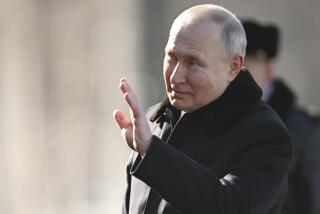Bush May Delay Resumption of Strategic Arms Talks
WASHINGTON — President-elect George Bush indicated Wednesday that he will postpone resumption of the U.S.-Soviet strategic arms reduction talks beyond Feb. 15, the date suggested for their resumption by the Reagan Administration when the talks recessed last month, so that his new team can have more time to prepare for negotiations.
Asked at a press conference about published reports that he would seek a delay in the talks, Bush emphasized that he wants progress in arms control but that it should be prudent and lasting. “I’m one who has always been a little bit cautious,” he said.
Bush advisers, including retired Lt. Gen. Brent Scowcroft, his designated national security adviser, have argued privately that the United States should develop a coherent approach to arms control policy, nuclear strategy and Pentagon weapons system purchases (such as mobile intercontinental missiles) before completing the strategic arms reduction treaty, whose goal is to cut offensive nuclear arsenals of each superpower by about 50%.
Tower Advises Review
At the same time, former Sen. John Tower, leading candidate for defense secretary and a former chief negotiator at the strategic arms talks in the Reagan Administration, has advised Bush to undertake a six-month review of strategic arms issues rather than immediately return to the table, according to a Tower aide. He also has counseled a go-slow policy toward conventional arms talks.
Tower’s rationale, the aide said, is that the prospective strategic arms treaty faces serious obstacles in the Senate and that the Bush Administration’s attitude on the issue should be thoroughly discussed with legislators before being laid before the Soviets in Geneva. Tower is a former Republican senator from Texas.
In a historical analogy, the first strategic arms limitation talks began in November, 1969, about nine months after the new Richard M. Nixon Administration undertook a comparable review, according to Jack Mendelsohn of the private Arms Control Assn. here.
Mendelsohn speculated that the negotiations should resume “by summer at the latest” if Bush is to avoid serious public criticism for foot-dragging. The need for early budget decisions on weapons systems also points to a relatively short delay, he said.
Answering questions at a press conference after he introduced his choice of Trade Representative Clayton K. Yeutter as the new secretary of agriculture, Bush also said that he would not be rushed into responding to Soviet President Mikhail S. Gorbachev’s announcement last week that Soviet armed forces would be cut by 500,000 men and that 5,000 tanks would be removed from Eastern Europe and dismantled over the next two years.
“I need time in order to assess the new (Gorbachev) proposals and to come up with our own,” he said. Government experts are examining the likely impact of the reductions, “and then when our national security team is together, we’ll have a hard Bush Administration look at it.”
‘A Constructive Step’
In another arms control development, State Department spokesman Charles Redman announced that Moscow has agreed to destroy two small anti-missile radar units located at Gomel, in Byelorussia. The units pose a “potential violation” of Moscow’s “legal obligation under the ABM (Anti-Ballistic Missile) Treaty,” the United States said last week in an Administration report on Soviet compliance with arms agreements.
While the Gomel radars are regarded as a minor issue in U.S.-Soviet relations, Redman termed the Soviet agreement to destroy them “a constructive step which, when fully carried out and verified, will satisfy our concerns regarding the illegal deployment of these radars.”
The 1972 ABM Treaty prohibits mobile anti-missile defense systems and their components (radars, interceptor missiles and missile launchers) except at designated test ranges. Elements that could be used in two types of Soviet ABM radars were identified last year in trailers at a Gomel electronics factory rather than at distant test ranges.
The Soviets last year invited U.S. arms control officials to examine the units at Gomel to show that no surreptitious activity was under way and implicitly agreed that a technical violation had occurred.
But the Soviets still have not resolved the issue of the Krasnoyarsk radar station, which is a far more serious violation of the ABM Treaty, Redman said. Until it is cleared up, he reiterated, it is “impossible for us to conclude any future strategic arms agreements” with the Soviet Union.
The United States has demanded that the two 10-story-tall radar units at Krasnoyarsk, which do not face outward and are not located on the Soviet borders as required by the ABM Treaty, must be dismantled.
At the United Nations, Gorbachev used the word dismantle in discussing the radar. Secretary of State George P. Shultz later confirmed at the New York meeting between Gorbachev and President Reagan that the Soviet leader had intentionally used the key word, but the subject was not further discussed, Redman said.
Bush, responding to a question on arms talks, said, “There is no way that we are going to have, by Feb. 15 or 16, a detailed point-by-point program. . . .
“We are going to start working vigorously, and I will send whatever signals it takes to . . . (indicate) that we want to move forward with arms control. I am interested in progress, but I want it to be prudent. I want whatever steps we take to be lasting.”
Times staff writer John M. Broder contributed to this story.
More to Read
Sign up for Essential California
The most important California stories and recommendations in your inbox every morning.
You may occasionally receive promotional content from the Los Angeles Times.










